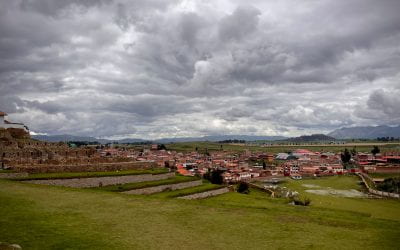
About the Author
Easton Bevel is a Master’s student at Harvard Extension School, where he is studying International Relations. His work focuses on the intersection of Religion and International Relations. He serves as an officer in the U.S. Air Force and holds graduate degrees in Islamic Studies and Psychology.
A Review of Born in Blood and Fire
The fourth edition of Born in Blood and Fire is a concise yet comprehensive account of the intriguing history of Latin America and will be followed this year by a fifth edition. As a part of my academic coursework, I was introduced to the book that provided an overview of U.S.-Latin American relations. Since then, it has become a valuable resource for me, helping me gain a thorough understanding of Latin American history and shaping my perspective of the region. The book’s insights have played an important foundational role in my work and studies in Latin America, without which my understanding of the subject matter would have been incomplete. I have referred to it on several occasions since my initial reading, and I am eagerly anticipating the release of its new edition this year.

Born in Blood and Fire by John Charles Chasteen (fourth and fifth editions) New York: W.W. Norton, 2016. 4th ed.; .W.W. Norton & Company Independent https://wwnorton.com/books/9781324069812/about-the-book/description , 5th edition)
The book provides a thorough exploration of the region’s cultural, historical, and geographical terrain. John Charles Chasteen, a cultural historian at the University of North Carolina at Chapel Hill, offers a nuanced analysis of the shared themes of racial diversity, nationalism, religion, and culture that have shaped Latin America over the centuries. Using a multinational lens, the book employs a chronological approach to examine a range of topics, including colonial rebellion, populism, liberation theology, criminal violence, and neoliberalism. The result is a thought-provoking and insightful analysis that sheds light on the complex and fascinating history of Latin America.
Born in Blood and Fire begins with a timeline and includes a variety of images, maps, and photographs throughout. First published by W. W. Norton and Company in 2001, this book has undergone three additional editions. The fourth edition was published in 2016 and features new content on several topics, such as colonialism, nationalism, the Cuban Revolution, and current political and economic issues. It was revised to emphasize current cultural analyses of Latin American society and to establish meaningful connections between the Encounter and the present.
The author is meticulous in chronologically detailing the journey of Latin America from the native civilizations to the contemporary era. The text not only covers the advanced empires of Aztec, Maya, and Inca, and the larger nations of Mexico and Brazil, but also the smaller pre-colonial cultures and nations of Peru, Cuba, Guatemala, and others in the post-colonial era. The author’s all-inclusive approach to religious and anti-religious sentiments, liberal and conservative ideologies, as well as the transcultural “melting pot” of immigration is noteworthy.
The author’s writing style is compelling and engrossing, replete with easy-to-follow statistical data and insightful biographical accounts of notable figures such as Carmen Miranda, Juan and Eva Perón, and Pablo Neruda. The author narrates fascinating tales, such as that of the rubber barons who constructed an opera hall deep in the Amazonian jungle. The narrative is all-encompassing, covering a broad range of subjects such as economics, politics, religion, race, and popular culture to fully capture the intricacies of Latin America’s long and tumultuous journey toward progress.
The anthology is an impressive collection of edited and translated works. It not only presents a set of analysis questions for written assignments or discussion, but also provides a well-structured organization into chronological chapters, each of which explores a diverse range of themes, such as the initial encounter with Europeans, the formation of national identities, opposition to neocolonialism, Cold War ideologies, and guerrilla warfare. Each chapter is preceded by a comprehensive introduction that provides an overview of the historical context, followed by three to six selections, each of which is introduced by a paragraph detailing the author’s significance in Latin American literature.
Chasteen’s publication skillfully navigates intricate class systems and diverse racial backgrounds, while addressing regional struggles that have persisted since the era of superstates and alliances among Mayan cities. The book adeptly tackles post- and neo-colonial errors and continuing social injustices, without coming across as condescending or self-righteous. One of the book’s strengths is its innovative approach to exploring new national identities and the United States’ often questionable treatment of its southern neighbors. Chasteen also provides valuable insights into how European notions of liberalism and nationalism have assisted in the prolonged struggle for political and economic independence among indigenous peoples. What distinguishes this historical account is its emphasis on the everyday lives of ordinary people, not just the well-known figures like Simon Bolivar, Che Guevara, and Canek, a Yucatec Maya who led a brief but significant rebellion against Spanish rule in Mexico in 1761.
While some may argue that the book may give too much attention to the larger countries, Chasteen has done an excellent job of providing a concise history within the limited space. This makes it an ideal resource for introductory undergraduate courses. For anyone seeking a comprehensive overview of Latin American history, this work should be the starting point. Born in Blood and Fire provides all the resources needed to set up a course, deliver lectures, develop assessments, and teach critical history skills. In addition to the book itself, there is a documents reader, Born in Blood and Fire: Latin American Voices, curated by Chasteen and a range of sources spanning the last six centuries. Chasteen translated many excerpts from essays, books, and newspaper articles.
The fourth edition was foundational reading for me as a novice in the field of Latin American studies. As I progress my academic career, I refer to the work as an example of how to analyze and concisely convey overarching historical developments. If tasked to teach a course on Latin American history in the future, the newest edition of the book will be required reading just as it was for myself. I highly recommend it for all levels of academic inquiry.
More Student Views
Colombian Women Who Empower Dreams
English + Español
The verraquera of Colombian women knows no bounds. This was the message left with me by the March 30 symposium, “Empowering Dreams: 1st symposium in honor to Colombian women at Harvard.”
Resilience of the Human Spirit: Seizing Every Moment
In the heart of Chicago, where I grew up, amidst the towering shadows of adversity, the lingering shadows of generational demons and the aroma of temptation, the key to the gateway of resilience and determination was inherited. The streets of my childhood neighborhood became, for many, prisons of poverty, plundering, crime and poor opportunity.
Andean Cultural Landscapes in Danger: The Chinchero International Airport
English + Español
Cusco stands as one of the most culturally and ecologically captivating regions globally.




